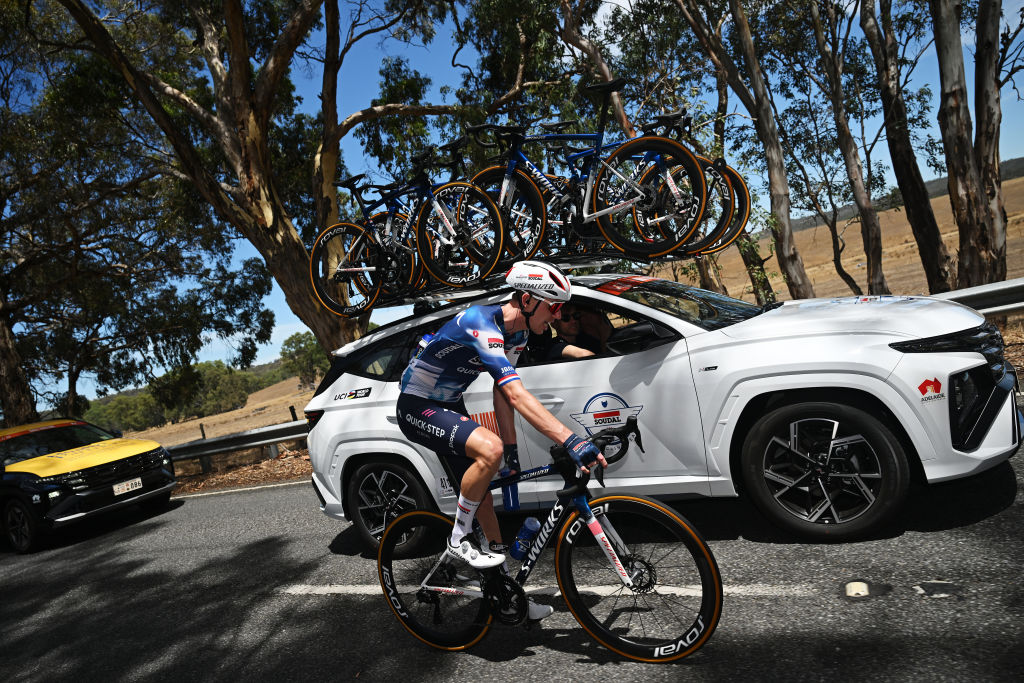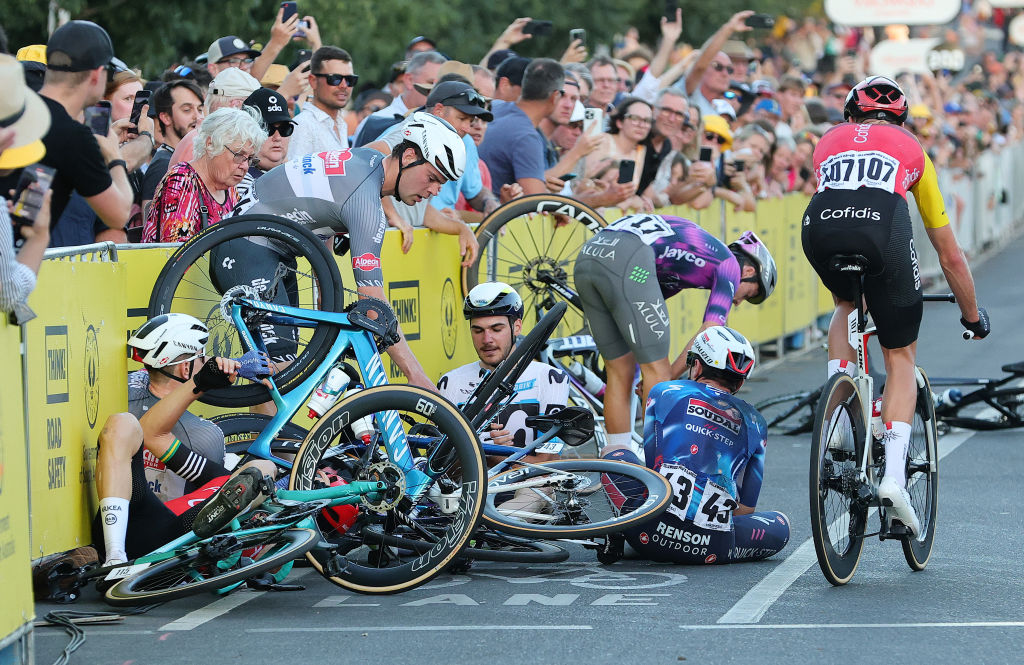
The men's peloton in the Tour Down Under are having to cope with what race director Stuart O'Grady called "a seismic shift" in the UCI regulations regarding feeding riders during the race.
Drafted on December 23, 2024 and made official on January 1, a new rule requires organisers to place official feed zones every 30-40 kilometres, and teams can only feed their riders from the roadside in those zones. The helpers handing out bidons and musettes must hold UCI licences and wear team clothing.
The new rule caused O'Grady and his organisation headaches, given it come so close to the start of the race.
"It was a very late regulation change, which has a massive impact on us being the first WorldTour event," O'Grady told Cyclingnews before the start of stage 2.
"We already had the tech guides printed and everything was already in place. So it's been a big adjustment. So we've had to get a lot of work done behind the scenes.
"Luckily, UCI are being flexible - we've listened to the teams. They wanted another one here and there, and everyone's just worked together to make sure it happened."
The temperature was pleasant the start of stage 2 in Tanunda but even with the milder weather, the rule is a big concern for the teams who have to ensure their riders get the drinks and food they need.
The rule was part of a broad revision to improve safety in the peloton, and restricting feeding from the roadside could avoid some danger of sudden changes in speed and dropped bidons.
O'Grady emphasised the extent of the rule change for the peloton.
"It's going to make it safer for sure, but in certain occasions I guess it's going to be interesting.
"For me, it's one of the biggest historical changes in cycling. It's a seismic shift, in my opinion," he said.
"I think we can all see the pros, but you can also see the cons on how you're going to control that. In Australia, it is a much easier environment to be able to control it. It's going to be very interesting to see how they control it when the guys get to Europe, specifically racing in Belgium."
Bahrain Victorious sports director Neil Stephens said the UCI has been open to adding more feeds than what was originally planned.
"What we've said to the UCI is, if it's accessible, if it's easy, and no one's going to be speeding, no one's going to be putting the people in trouble, why not? Let's do it," Stephens told Cyclingnews.
"For example, today, we're going up [Menglers Hill] - I'm going to have people on the top giving me information. Can we allow those people to feed? They originally said no, then we explained the reasoning and they allowed it.
"On the stage to Willunga [stage 5], we're going to be in place ready to feed the next lap, why can't we do bottles the lap before? So they've just used logic.
"We've got to congratulate ourselves a little bit, the teams, because we didn't go to them with a problem, we went with a solution. We've got to work together with the UCI and with the race organisers for the benefit of everybody."
Tom Southam, sports director for EF Education-EasyPost, said he hopes the new rules will enhance safety for the riders, but agreed that the feed zone rule is a big change.
"I think everybody would like to see it work. We have to adapt. We've got young riders who have never come to the car for a bottle," Southam told Cyclingnews. The feed zones might work to slow the race down "a little bit, but you double the work of the cars going around" to service riders between feed zones.
During the Tour de France, EF Education-EasyPost, he said, "had bidons everywhere" - with staff leapfrogging the race to feed along the roadside so riders didn't have to go back and forth from the convoy. "You could basically sit at the back of the last group [and be sure] the guys aren't going to get thirsty. They're not going to get dehydrated, because every X kilometres [they can get a bottle].
"Now we're going to have to do feed from the car, and then [you have to] pass the group, and you hammer up however many kilometres an hour to get to the next guy, and you have the hammer to get to the next guy."
Daryl Impey, sports director for defending champions Israel-Premier Tech, confirmed that the teams were prepared to adapt.
"It's more about looking after the riders than just trying to get an advantage on people. But if that's the new standard, we'll all just have to work with it. Then the riders will have to learn how it used to be in the old days and come back [to the team car] for bottles.
XDS-Astana sports director Mark Renshaw wasn't against the feed zone rules, saying, "It makes it easier, in one sense, because we know the points, we supply the points to the soigneurs and they go to the point, they know what to give. Whereas last year it was up to the teams to pick where and when [to feed]."
Having set zones where the soigneurs go to feed the riders, he said, means less logistics and less staff needed.
Safety on everyone's mind

The Tour Down Under already had the topic of safety come up when there was a big crash in the final corner of the pre-race criterium. Two riders - Miles Scotson (Arkéa-B&B Hotels) and Manilo Moro (Movistar) couldn't start the stage race as a result and one spectator was hospitalised in the incident.
While the organisers had altered the course so that the sun wasn't in the riders' eyes and ensured the turns were all wide, the massive increase in speed on the final lap provided a good example of how a turn riders took 29 times without incident changed for the worse at pace.
Michael Rogers, who now works with Lidl-Trek's management, previously was the UCI’s Head of Innovation and Esport and led the federation's safety initiative called SafeR, which he said was a "huge step forward". However, safety has not perhaps kept pace with the rapid changes in pro cycling.
"The sport is just evolving so fast. When you look at the investment in the sport in general globally, probably 90% of that has gone into increasing performance and technology.
"The safety side of it has maybe lagged a bit, and you have such a vast range of organizers - there are some full-time professional organizations. But on the other side, there are also wonderful people at some races that volunteer all their time and it's not a professional organization. To make those all in unison, that's really difficult."
Rogers said that safety is an "extremely complex topic" and "it's difficult to regulate your way out of this," but said education will be key. "I've been out for a little while, but, you know, it feels like it's starting to come together."
Meanwhile, the onus is on the teams and riders of the Tour Down Under to adapt to the new rules.
There have been two crashes in two races so far this season, and both were in the final kilometres where riders are fighting for the win.
"I don't know how to stop it," Southam said. "We don't have a safe stadium.
"You can do all the measures you want, but the fact of the matter is, the pressure is always going to be there."
Get unlimited access to all of our coverage of the season-opening 2025 Tour Down Under - including breaking news, analysis and more, reported by our journalists on the ground from every stage as it happens. Find out more.







